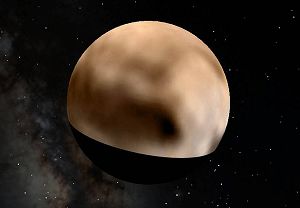This article is more than 1 year old
DOUGHNUT (donut?) and whale FOUND ON PLUTO
E-minus 7 days until NASA's space lab gets intimate with strange dwarf
Flyby sequence initiated

Independence Day was almost a terrible day at NASA mission control, when the New Horizons spacecraft suddenly stopped talking to them. Fortunately the probe's strop lasted a relatively minor eighty minutes, before it got back in contact for some angry make-up science.
The investigation into the anomaly confirmed that the main computer had been overloaded due to a timing conflict in the spacecraft command sequence.
The computer was tasked with receiving a large command load at the same time it was engaged in compressing previous science data which caused the main computer to respond precisely as it was programmed to do: by entering safe mode and switching to the backup computer.
Although 30 observations were lost during the three-day recovery period, these observations represented "less than one per cent of the total science" that the New Horizons team hoped to collect between 4 July and 16 July.
Scientific readings were lost from the early afternoon on Saturday until Tuesday, when they began to come through again, according to Dr Alan Stern, New Horizons principal investigator.
Stern said that "the command decision I made, and the team agreed with, was that it is more important to focus on getting ready for flyby than to collect science from eight or nine million miles out".
NASA reported that none of the mission's most critical observations were affected, and state there is no risk of the anomaly repeating before the flyby, as no similar operations are planned for the remainder of the Pluto encounter.
"This is a speed bump in terms of the total return we expect to receive from this historic mission," said Stern. "When we get a clear look at the surface of Pluto for the very first time, I promise, it will knock your socks off."
Mission managers reported during a July 6 media teleconference that the Plutonian probe resumed operations on its main computer overnight.
Houston, we're sorted
The sequence of commands for the Pluto flyby have now been uplinked to the spacecraft, and full observations of Pluto, its moons and the solar winds resumed at 12:34pm EDT, 7 July, meaning the probe is now E-minus seven days from its close flyby of the outrageously demoted dwarf planet.
As NASA notes, space exploration geeks will be familiar with the term T-minus, or Time-minus, as used in rocket launch countdowns. The term E-minus is used when a spacecraft is in space to help with mission planning. "The 'E' stands for 'encounter'," explained Tim Larson, the EPOXI mission project manager.
The quick response to the weekend's computer glitch, the boffins are assured, means that the mission remains on track to conduct the entire close flyby sequence as planned, including the 14 July observations.
"We're delighted with the New Horizons response to the anomaly," said Jim Green, NASA's director of planetary science. "Now we're eager to get back to the science and prepare for the payoff that's yet to come."
